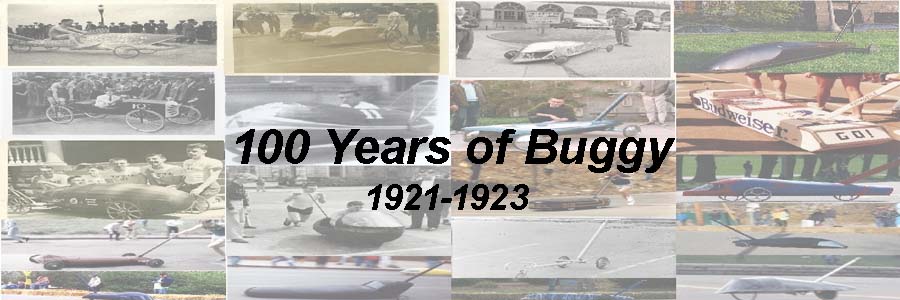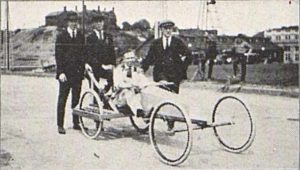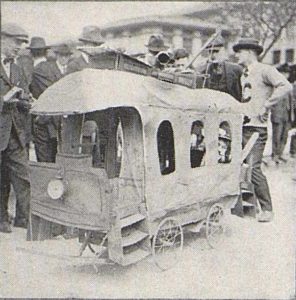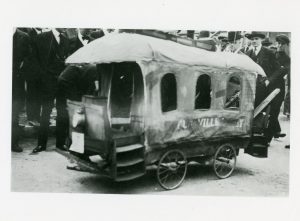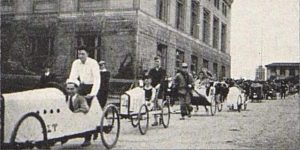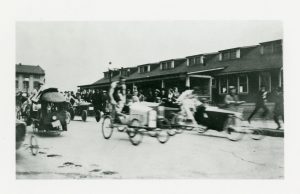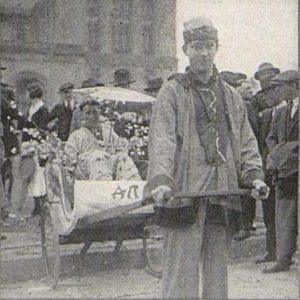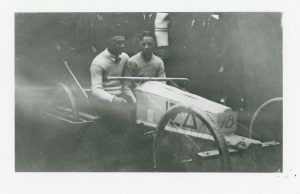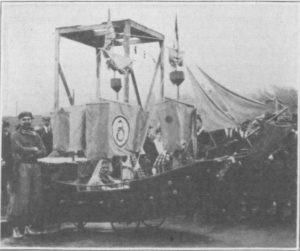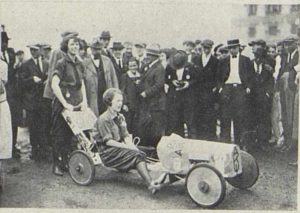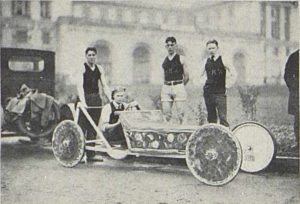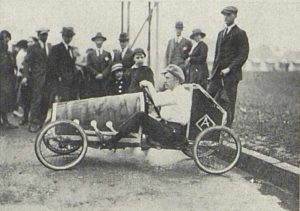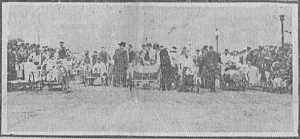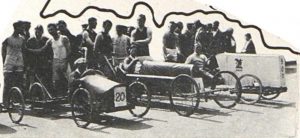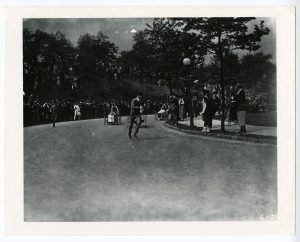Table of Contents: Intro & 1920; 1921-1923; 1924-1927; 1928-1932; 1933-1935; 1936-1939; 1940-1945; 1946-1949; 1950-1953; 1954-1956; 1957-1959; 1960-1963; 1964-1966; 1967-1969; 1970-1973; 1974-1976; 1977-1979; 1980-1983; 1984-1986; 1987-1989; 1990-1993; 1994-1996; 1997-1999; 2000-2003; 2004-2006; 2007-2009; 2010; 2011; 2012; 2013; 2014; 2015; 2016; 2017; 2018; 2019; Recap & 2020; 2021; 2022
This week, 100 Years of Buggy History takes a look at the early 1920s: 1921-1923. It’s a period full of interesting designs and controversies, plus some rule changes as the students worked to make the sport endure. And…history was made, with the first ever women’s team competing against the boys, 55 years before women’s teams were welcomed more generally into Raceday.
1921
Raceday: Friday, May 13, 1921 at 10:30am
Sweepstakes Chair: Unknown
Race Results: (1) Iota Sigma Delta (Skeleton) (4:38), (2) Gamma Mu Epsilon (4:42), (3) Xi Sigma Upsilon (5:04)
Design Comp: (1) Delta Upsilon (Fish); (Honorable Mention) Sigma Nu (Toonerville Trolley)
Weather: “Ideal” – Morning clouds gave way to sunshine; temperature unknown.
The April 27, 1921 issue of The Tartan promoted Raceday 1921, taking place on the 2nd day of Campus Week, as the “funniest event of the program”, noting that “anyone who has a weak heart should be accompanied by an undertaker…No arrangements have been made to undertake or care for anyone but the racers.” Among the drivers of the 18 teams competing were “some of the most infamous agitators of the human race”. But aside from the humorous introduction to Raceday 1921, here’s what we know about the year:
- Rule Changes – Teams Grow, Complexity Shrinks. The “rulebook” in 1921 again consisted of only 5 rules, but the 5 rules were different from 1920. Rules requiring buggies to have 4 wheels and 1 driver and 1 pusher at a time remained, as did the rule limiting participation to fraternities. But gone were the requirements to swap rear wheels and the ability to change places at any time, the weight limit had been lowered from 75 to 50 pounds, and teams grew from 2 to 4. With respect to team size and transition zones, the teams were essentially set up as 2 teams of 2 – Rather than having the pusher and driver swap places with each other, now the pusher and driver were each required to be replaced by a fresh pusher and driver for the final portion of the race, outside Machinery Hall (present-day Hill 3) to the finish line.
- Crowds Gather. According to the May 14, 1921 edition of the Pittsburgh Post-Gazette, 2,000 people headed to the Buggy course to watch the race.
- Orgs. 18 teams competed in 1921. We don’t know all 18, but among the competitors were: (1) Beta, (2) DU, (3) Phi Epsilon Pi, (4) SAE, (5) SigNu, (6) Theta Xi, (7) Xi Sigma Upsilon, (8) Delta Epsilon Omega (XSU and DEO would merge in 1922 to become Delta Xi, which would become ATO in 1923), (9) Woodlawn Club, (10) Tau Gamma Phi (became DTD in 1923), (11) Kappa Sigma Rho, (12) Alpha Pi, (13) Iota Sigma Delta (became Alpha Sigma Phi in 1925), (14) Gamma Mu Epsilon (which became Theta Tau in 1922, and went inactive in 1948 following a scholarship issue), and (15) Zeta Delta (which became PiKA in 1922). We think that the remaining 3 teams were KapSig, Square-and-Compass Club, and Sigma Epsilon Phi (which became SigEp in 1925).
- Pre-Race Incident – SigNu vs. US Army: Raceday got off to a bit of an inauspicious start. After presenting the buggies for display and judging of the design competition, SigNu was nearly knocked out of the race when an army truck (which routinely roamed the campus in 1921) failed to stop as SigNu’s buggy was crossing in front of it. Luckily, thanks to the audible gasps and screams of the crowd, SigNu was able to escape injury and the brothers left with minor scratches as they got away from the truck.
- Racing Troubles for Many Orgs. The race itself was not the prettiest either; in fact, only half of the teams actually finished the race. Tau Gamma Phi (DTD), who won the race in 1920, didn’t even make it to the present-day Hill 1, as they lost a wheel making the first turn of the race on to Tech Street. If you look closely at the image to the right, you can actually see Tau Gamma Phi’s buggy (white, just to the left of #1) already lopsided, and a random wheel on the far right. Multiple other organizations crashed into them, and the “crashing of timber and the shrieking of the crews stilled the blood of the on-lookers…it was only by some strange kind of fate that the men received only scratches instead of serious injury.” In addition, Beta’s and Alpha Pi’s buggies both broke down on the course and they dropped out of the race.
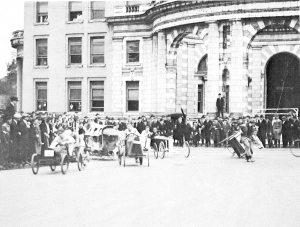
- Major Crash. The worst incident came of the race came from SAE. SAE was looking good early, and had a lead for a while, but while coming down the freeroll at a high rate of speed, the steering apparatus broke and threw the buggy off the road. The buggy either hit the curb and tore off two wheels (per the Tartan) or smashed to pieces against a stone wall (per the CIT Alumnus). Either way, both driver (Wilson) and pusher (Ted) were “hurled through the air” and after they landed, the Buggy landed on top of them “pinning them to this hard world. And thus they remained until rescued.”
- Race Results. Once SAE crashed, Iota Sigma Delta assumed the lead and never looked back. The full non-DNF finish order: (1) Iota Sigma Delta (Alpha Sig), (2) Gamma Mu Epsilon (Theta Tau), (3) Xi Sigma Upsilon (ATO), (4) Kappa Sigma Rho, (5) Phi Epsilon Pi, (6) SigNu, (7) Delta Epsilon Omega (ATO), (8) Woodlawn Club, and (9) DU.
- ISD’s winning team was comprised of Arthur W. Hedgren, Edwin W. Olstolf, Leroy L. Byerly, and “Wilson”
- GME’s 2nd place team consisted of M.W. Obenour, A.D. Swecker, W.J. Allen, and J.J. Pannek
- Design. In 1921, not all of the Buggies were built for speed. Some were just creative, in an attempt to win the Design Competition. And it worked! The winner was DU’s green fish (see photo right), but other creative designs included SigNu’s replica of the Toonerville Trolley, a cartoon trolley that ran in newspapers from 1908-1955, and Alpha Pi’s “elaborately decorated” rickshaw (see photos at the bottom for SigNu and Alpha Pi’s buggies).
- 1921 Photos. Below are some additional photos from 1921.
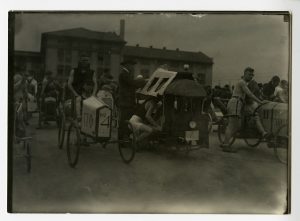
Identified Buggies: #4 (front left) – Tau Gamma Phi (became DTD in 1923); #7 – SigNu’s Toonerville Trolley

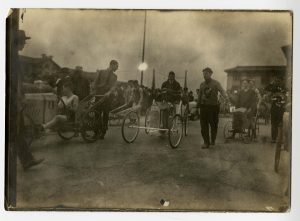
Identified Buggies: #1 – Zeta Delta (front center); DU’s Fish Buggy (pushbar visible behind #11)
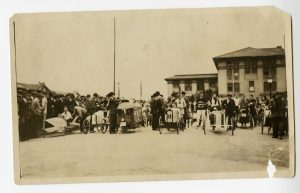

1922
Raceday: Friday, May 26, 1922 at 10:00am
Sweepstakes Chair: R.E. Hedlund
Race Results: (1 – TIE): SAE and PiKA (4:30); (3) Delta Mu
Design Comp: Sigma Nu (Pirate Ship)
Weather: Rain (0.75 inches fell in Pittsburgh that day); Temperature unknown.
Rain fell on Friday morning, but that wasn’t going to stop Buggy from making its third annual running. 1922 brought the first ever (but certainly not the last) major controversy in Buggy history, saw history made (and seemingly forgotten), and was the first time that Buggy had to deal with a common problem over the last 100 years – Crowd Control.
- Course Under Construction. An article in the May 17, 1922 Tartan indicated that the Buggy course for 1922 was being constructed, though I assume that meant it would be under construction. The winning bid for the construction came from Booth & Flinn, at a cost of $1 million, with various sources of materials. The article notes that the bid seems a little high, “but when you figure that our boys will make about 75[mph] on the straightway and even 90 on the turns you’ll realize that it is necessary that we have a first class road bed.” The course at the time was, at least in part, a stone road, so construction is certainly possible; but between the speed, the timing, and the cost, something about this article seemed a little odd.
- Design Comp. The Design Competition trophy went to Sigma Nu, who entered their Pirate Ship, captained by Cy Comfort (see photo right).
- Getting on the Course is Easy; Completing it isn’t. Buggy had a record 20 entrants in 1922. But while many entered, few finished. The course ended up “lined with nuts, bolts, wheels, and overturned” buggies. One example was DU’s “Grasshopper” Buggy. DU was a little too “frisky” as it rounded the first turn onto the present-day Hill 1, and it took a jump over the curb, knocking it out of the race.
- History…or Herstory. One of the 20 entrants in 1922 made history…or should we say herstory? Women’s racing didn’t officially begin until 1979, but women racing began in 1922, when the Alpha Kappa Psi sorority entered a buggy on Raceday! Unfortunately, they weren’t able to finish the race without incident either, as they wrecked on the course (it’s unclear if they crossed the finish line)
- Leader goes down. The race itself looked like it was going to be a classic battle between SAE and SigEp (Sigma Epsilon Phi, which became Sigma Phi Epsilon in 1925). SigEp, with Buggy #1 (buggies were given numbers back then), led early on, but at the top of present-day Hill 2, SAE caught up to SigEp. In the freeroll, SigEp took the lead back and was ahead by 100 feet when suddenly SigEp lost one of their rear tires, enabling SAE and several others to pass.
- Controversial Finish. The first major controversy in Buggy history came as the teams approached the finish line. PiKA had finally caught up to SAE as they approached the straightaway to the finish line. But there were so many spectators around the finish line that they crowded the course, leaving just a narrow pathway down the middle of the road that was only wide enough for one Buggy. The two Buggies both aimed for the single lane and collided, ultimately crossing the finish line together, radiator-to-radiator. Due to the size of the crowd and the spectators running to the finish line, the judges were unable to see which buggy actually crossed the finish line first. Ultimately, Sweepstakes decided, for the first and only time in Buggy History, to declare race a tie, awarding a trophy to both teams. But they only had 1 trophy available to present to the winner!. So, according to a letter to the editor from R. E. Hedlund in 1956, he was given another $10 by the Campus Week Committee to go out and buy an additional trophy.
- 1922 Photos. Below are some additional photos from 1922:
1923
Raceday: Friday, May 25, 1923 at 10:00am
Sweepstakes Committee: H.D. Sonnemann (Chair), W.A. Anderson, D.R. Williams, W.B. Cunningham
Race Results: (1) KapSig (#19), (2) Theta Xi (#8), (3) SAE (#3), (4) Delta Xi (#10)
Design Comp: Delta Xi (Winner); SAE and KapSig (Honorable Mention)
Weather: Sunny; 85 Degrees (Low of 47)
“The fourth annual death-defying, nerve-thrilling, hair-raising, stupendous, extraordinary event of all events” took place in 1923. The controversy of 1922 resulted in some new rules for 1923 to avoid the same type of situation, and instead of having just 1 pusher (or 2 pushers/2 drivers), the teams were expanded to 4 pushers. But the real name of the game in 1923? Wheel technology.
- New Rules – More Pushers, Fewer Athletes, Less Buggy Variety. There were a few complaints about past years that led to new rules in 1923. One was based on the 1922 controversy – Sweepstakes needed a way to keep spectators off of the course. Another was around the Design Competition – certain organizations were creating clever looking designs (such as the prior Design Comp winners, the Fish and the Pirate Ship) that were not feasible as racing competitors. Furthermore, the varsity track coach (Coach Beeler) was concerned that running over stone roads could injure his athletes, so track athletes were prohibited from pushing. And lastly, it turns out that pushers get tired and breaking up the course into smaller segments is more effective (also, the minimum buggy weight was increased to 60 pounds). The new rules were:
- Each team now consists of 1 driver and 4 pushers
- There is 1 pusher at a time, and the pushers change in designated transition zones
- No one receiving a letter in track or cross-country is eligible to push
- “Freak” buggies, such as fish, chariots, cigars, grasshoppers, and ships are not eligible for Design Competition
- Any spectator on the course while the race is being run will cause his fraternity to be DQ’d
- Course adds Transition Zones. Because the race now incorporated 4 pushers with set transition zones, those transitions needed to be determined. Thus, the course changed slightly and the transition zones were demarcated (see photo at right, from 1924, though it applied only in 1923).
- Crowd Control. Another change to the 1923 course was that the finishing stretch of the race would be roped off, to further prevent spectators from crowding the field and obstructing the view of the judges.
- Practice Incident. Practices began at least a few weeks before Raceday, and our first known practice accident was reported on May 2, 1923. We don’t know which organization, or where it occurred, but “the demolished appearance of the racer, which was hauled back to its garage by means of a Ford, certainly made an impression of disaster.”
- Race Results. 16 Buggies were entered in 1923, but the race was really a battle of the top 3. SAE started the race out in front, and led going into the first turn (present day Hill 1). The gap closed in the freeroll, and by the time they reached the final transition (from Pusher 3 to Pusher 4), SAE, Theta Xi, and KapSig were all bunched together. From there, KapSig’s final pusher, D.V. Beeder, took over and grabbed the lead for good, powering KapSig to victory. The winning KapSig team consisted of E.R. Roller (Driver), H.C. Wurtenberger, P.A. Morrison, W.D. Shelton, and D.V. Beeder (Pushers).
- Wheel Technology. It turns out that the key to KapSig’s success may have been wheel technology. KapSig reached out to S.A. Pickering, a Pittsburgh-based harness racing horse owner, and got him to lend them 4 wheels from the wagon of his harness horse, Dr. Strong. Those wheels were not just successful on the harness track; they guided KapSig to Buggy victory.

